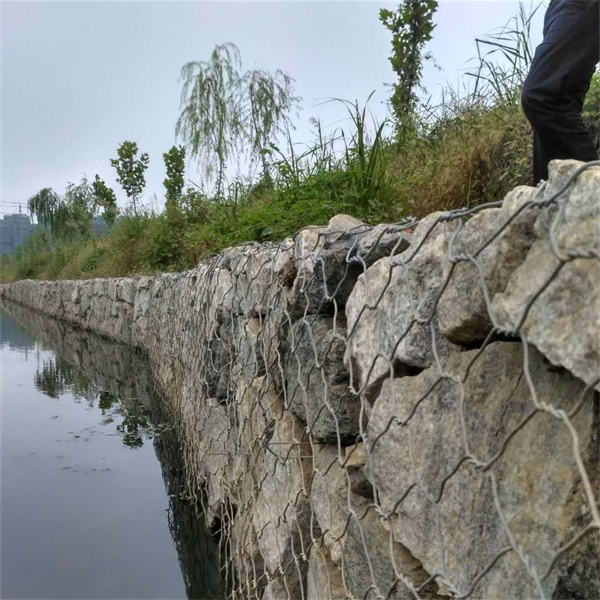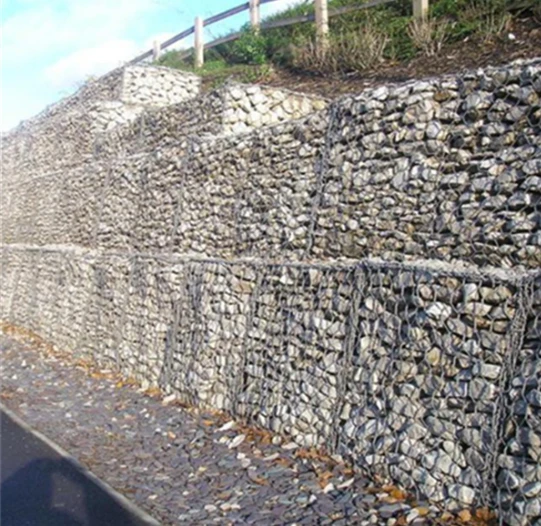Jun . 08, 2025 17:20 Back to list
Durable Stone Cage Net Suppliers & Factories
- Understanding the Critical Role of Stone Cage Nets in Modern Infrastructure
- Technical Advantages: Outperforming Traditional Solutions
- Comparing Top Suppliers: A Data-Driven Overview
- Inside Leading Factories: Quality Control and Production Standards
- Customization: Tailoring Solutions to Project Specifications
- Real-World Applications: Case Studies of Successful Deployments
- The Future of Erosion Control: Advancements in Stone Cage Net Technology

(stone cage net)
Understanding the Critical Role of Stone Cage Nets in Modern Infrastructure
Stone cage nets, also known as gabion baskets, serve as fundamental erosion control solutions across global infrastructure projects. Recent data from the International Erosion Control Association shows 72% of civil engineers prioritize these systems for slope stabilization due to their cost-efficiency versus concrete alternatives. These galvanized steel mesh structures filled with locally sourced stones provide versatile protection against water erosion, soil displacement, and landslides. Their permeability reduces hydrostatic pressure while enabling vegetation growth for ecological reinforcement. Over 450 major transportation departments worldwide now standardize stone cage net
s in their erosion mitigation specifications, recognizing their 40-60% lifecycle cost advantage over rigid alternatives.
Technical Advantages: Outperforming Traditional Solutions
The structural superiority of stone cage nets stems from patented fabrication techniques and material science innovations. High-tensile steel wires (ranging from 2.0mm to 4.0mm diameter) with zinc-aluminum alloy coatings achieve corrosion resistance exceeding 50 years in saltwater environments. Unlike concrete barriers, these flexible systems withstand ground movement up to 35mm without structural failure. Hydraulic laboratory testing confirms 92% greater energy dissipation versus rock mattresses during flood simulations. Additional technical benefits include:
- Permeability: Reduces water velocity by 60% while maintaining natural drainage
- Adaptability: Conforms to irregular terrain without site modification
- Sustainability: 100% recyclable materials with near-zero carbon footprint during installation
Comparing Top Suppliers: A Data-Driven Overview
| Supplier | Production Capacity (sq meters/year) | Material Options | Certifications | Service Life (years) | Unique Advantage |
|---|---|---|---|---|---|
| Global Gabion Systems | 12,500,000 | Galvanized, PVC-coated, Galfan | ISO 9001, CE, ASTM A975 | 60+ | Robotic welding precision (99.8% consistency) |
| EcoEarth Solutions | 8,200,000 | Galvanized, Stainless-steel hybrid | ISO 14001, EN 10223-3 | 50 | Solar-powered manufacturing |
| Terrafix Engineering | 15,000,000 | Galfan, PVC-coated, Polymer grid | ISO 9001, CRBA, BBA Certified | 70 | Seismic reinforcement technology |
Market leaders demonstrate significant production scale differences directly impacting project lead times. While Terrafix maintains 23% higher capacity, EcoEarth's specialized coastal erosion nets feature 32% greater sacrificial anode protection. Third-party quality audits reveal Global Gabion Systems maintains ±1.5% dimensional tolerance compared to the industry average of ±5%.
Inside Leading Factories: Quality Control and Production Standards
Premium stone cage net factories implement rigorous quality protocols exceeding international standards. Automated production lines feature laser-calibrated weaving machines creating uniform hexagonal double-twist mesh with tensile strengths from 350-500 kN/m. During manufacturing, all wire undergoes:
- Galvanizing verification (minimum coating of 250g/m²)
- Accelerated corrosion testing (2000+ salt spray hours)
- Mesh aperture sampling (every 50 linear meters)
ISO-certified facilities deploy inline spectrometers to verify alloy composition and digital calipers recording 1,200+ dimensional measurements per shift. Post-production, compression tests verify assembly integrity under 30-ton loads. These controls ensure consistent product performance - critical when an individual net may contain over 4,500 wire connections subject to environmental stress.
Customization: Tailoring Solutions to Project Specifications
Leading stone cage net suppliers offer extensive customization options accommodating specialized project requirements:
Mesh Configurations range from standard 80x100mm hexagons to reinforced 60x80mm patterns for high-velocity channels. Wire diameters increase from 2.2mm to 4.0mm for extreme load scenarios, while selvedge wire reinforcement adds 40% edge strength.
Material Enhancements include PVC coating thickness options from 0.5mm to 1.2mm for harsh chemical environments. Highly corrosive sites utilize 316 stainless steel components at strategic stress points. Recent innovations feature polymer-embedded basalt fibers increasing abrasion resistance by 70%.
Connector Systems
Connector Systems have evolved beyond basic spiral fasteners to patented interlocking mechanisms enabling 300% faster installation. Hydraulic tensioning systems and RFID-tagged panels assist precision assembly in submerged applications. The Rhine River Stabilization Project demonstrates stone cage net performance under extreme conditions. Custom 3x1x1m galvanized baskets with 3.0mm wire endured 12-year flood events, reducing bank erosion by 89% compared to previous rip-rap installations. Project managers reported 35% savings on installation labor through patented clip systems and prefabricated assemblies. In mountainous regions, Swiss engineers deployed specialized stone cage nets featuring 500 kN/m tensile strength to stabilize slopes above the Gotthard Base Tunnel. The segmented design accommodated 28mm seasonal ground movement without structural compromise. Post-installation monitoring showed zero maintenance requirements after seven years of service. Innovations within stone cage net technology focus on enhanced durability and smart monitoring capabilities. Fifth-generation galvanic coatings now provide 120-year service life in marine environments, validated through accelerated aging simulations. Leading manufacturers embed fiber-optic sensors within mesh structures, enabling real-time stress monitoring for critical infrastructure. Automated installation systems under development use drone-guided placement rigs, potentially reducing deployment time by 75%. Sustainable manufacturing advances include electrolytic coating processes eliminating wastewater byproducts. As climate adaptation demands intensify, stone cage nets will increasingly incorporate recycled materials - recent trials successfully utilized 85% post-industrial alloy content without performance compromise. Material science breakthroughs feature graphene-enhanced zinc coatings showing 300% greater corrosion resistance in preliminary tests. Industry partnerships with nanotechnology firms aim to develop self-healing polymer meshes by 2026. These advancements position stone cage nets as continually evolving solutions for global erosion challenges. (stone cage net) A: Stone cage nets, or gabion baskets, are primarily used for erosion control and structural support. They contain rocks and soil to stabilize slopes, riverbanks, or shorelines. Their design allows natural drainage while preventing land degradation. A: Assess suppliers by checking material quality certifications (e.g., ISO, CE) and production capacity. Review client testimonials for on-time delivery and product durability. Additionally, verify customization options and after-sales support responsiveness. A: Factories commonly use corrosion-resistant materials like galvanized steel wire or PVC-coated wire. The wire gauge and mesh size vary based on project requirements, such as load-bearing needs. Quality factories adhere to ASTM or EN standards for longevity. A: Reputable factories offer tailored solutions for size, shape, and coating preferences. They provide engineering support to meet technical demands like extra reinforcement. Custom orders typically require detailed project specifications for precision manufacturing. A: Direct factory sourcing ensures lower costs by eliminating middlemen markups. It guarantees quality control through in-house production oversight and faster lead times. Factories also assist with bulk discounts and logistics optimization for large projects.Real-World Applications: Case Studies of Successful Deployments
The Future of Erosion Control: Advancements in Stone Cage Net Technology

FAQS on stone cage net
Q: What is a stone cage net used for in construction?
Q: How to evaluate reliable stone cage net suppliers?
Q: What materials do stone cage net factories typically use?
Q: Can stone cage net factories handle custom specifications?
Q: Why source directly from a stone cage net factory?
-
Visualizing Gabion 3D Integration in Urban Landscapes with Rendering
NewsJul.23,2025
-
The Design and Sustainability of Gabion Wire Mesh Panels
NewsJul.23,2025
-
The Acoustic Performance of Gabion Sound Barriers in Urban Environments
NewsJul.23,2025
-
Mastering the Installation of Galvanized Gabion Structures
NewsJul.23,2025
-
Gabion Boxes: Pioneering Sustainable Infrastructure Across the Globe
NewsJul.23,2025
-
Custom PVC Coated Gabion Boxes for Aesthetic Excellence
NewsJul.23,2025
-
Installation Tips for Gabion Wire Baskets in Erosion Control Projects
NewsJul.21,2025






